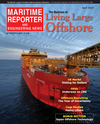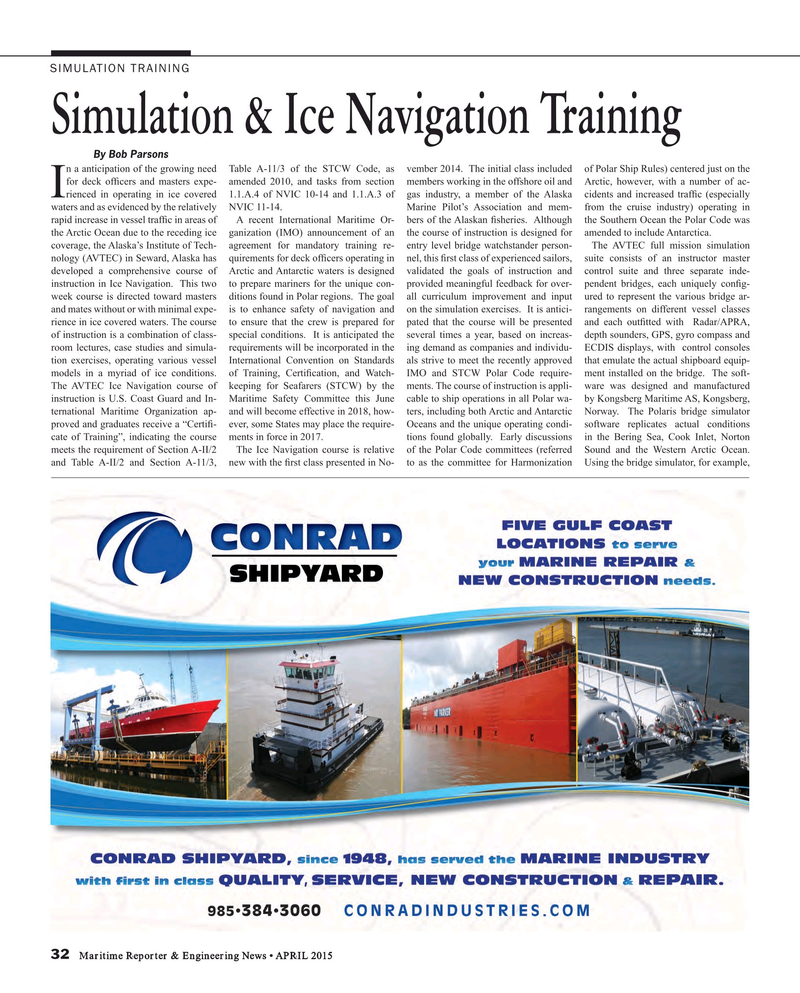
Page 32: of Maritime Reporter Magazine (April 2015)
Offshore Edition
Read this page in Pdf, Flash or Html5 edition of April 2015 Maritime Reporter Magazine
SIMULATION TRAINING
Simulation & Ice Navigation Training
By Bob Parsons n a anticipation of the growing need Table A-11/3 of the STCW Code, as vember 2014. The initial class included of Polar Ship Rules) centered just on the for deck of? cers and masters expe- amended 2010, and tasks from section members working in the offshore oil and Arctic, however, with a number of ac-
Irienced in operating in ice covered 1.1.A.4 of NVIC 10-14 and 1.1.A.3 of gas industry, a member of the Alaska cidents and increased traf? c (especially waters and as evidenced by the relatively NVIC 11-14. Marine Pilot’s Association and mem- from the cruise industry) operating in rapid increase in vessel traf? c in areas of A recent International Maritime Or- bers of the Alaskan ? sheries. Although the Southern Ocean the Polar Code was the Arctic Ocean due to the receding ice ganization (IMO) announcement of an the course of instruction is designed for amended to include Antarctica.
coverage, the Alaska’s Institute of Tech- agreement for mandatory training re- entry level bridge watchstander person- The AVTEC full mission simulation nology (AVTEC) in Seward, Alaska has quirements for deck of? cers operating in nel, this ? rst class of experienced sailors, suite consists of an instructor master developed a comprehensive course of Arctic and Antarctic waters is designed validated the goals of instruction and control suite and three separate inde- instruction in Ice Navigation. This two to prepare mariners for the unique con- provided meaningful feedback for over- pendent bridges, each uniquely con? g- week course is directed toward masters ditions found in Polar regions. The goal all curriculum improvement and input ured to represent the various bridge ar- and mates without or with minimal expe- is to enhance safety of navigation and on the simulation exercises. It is antici- rangements on different vessel classes rience in ice covered waters. The course to ensure that the crew is prepared for pated that the course will be presented and each out? tted with Radar/APRA, of instruction is a combination of class- special conditions. It is anticipated the several times a year, based on increas- depth sounders, GPS, gyro compass and room lectures, case studies and simula- requirements will be incorporated in the ing demand as companies and individu- ECDIS displays, with control consoles tion exercises, operating various vessel International Convention on Standards als strive to meet the recently approved that emulate the actual shipboard equip- models in a myriad of ice conditions. of Training, Certi? cation, and Watch- IMO and STCW Polar Code require- ment installed on the bridge. The soft-
The AVTEC Ice Navigation course of keeping for Seafarers (STCW) by the ments. The course of instruction is appli- ware was designed and manufactured instruction is U.S. Coast Guard and In- Maritime Safety Committee this June cable to ship operations in all Polar wa- by Kongsberg Maritime AS, Kongsberg, ternational Maritime Organization ap- and will become effective in 2018, how- ters, including both Arctic and Antarctic Norway. The Polaris bridge simulator proved and graduates receive a “Certi? - ever, some States may place the require- Oceans and the unique operating condi- software replicates actual conditions cate of Training”, indicating the course ments in force in 2017. tions found globally. Early discussions in the Bering Sea, Cook Inlet, Norton meets the requirement of Section A-II/2 The Ice Navigation course is relative of the Polar Code committees (referred Sound and the Western Arctic Ocean. and Table A-II/2 and Section A-11/3, new with the ? rst class presented in No- to as the committee for Harmonization Using the bridge simulator, for example, 32 Maritime Reporter & Engineering News • APRIL 2015
MR #4 (26-33).indd 32 MR #4 (26-33).indd 32 3/31/2015 3:49:18 PM3/31/2015 3:49:18 PM

 31
31

 33
33
